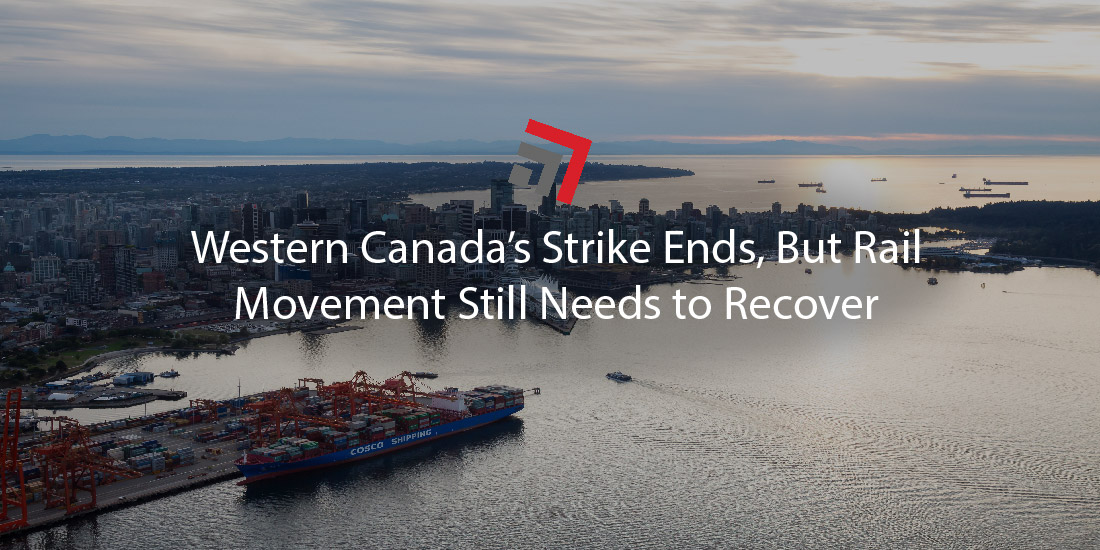Last Thursday, everyone in logistics let out a sigh deep from the delves of panic. A tentative agreement on a four-year labor contract was finally reached on Canada’s West Coast.
The feat marks an end to a protracted period of uncertainty for West Coast ports—U.S. and Canadian alike.
The new deal also spells an end to a near two-week labor strike that hit the Western Canadian ports of Vancouver and Price Rupert. Around 7,400 dockworkers staged this job-related action after their port employers failed to see eye-to-eye on certain terms.
The 13-day strike shuttered Vancouver and Prince Rupert leading to supply chain unrest, particularly for freight rail movement.
While the agreement relinquishes this disruption from inflicting even more damage, the aftermath it leaves will still haunt rail trade for the coming weeks, if not months.
Rail movement, import flow crunched by strike
13 days is an eon when it comes to a transport network’s operations being halted. Aside from the ports’ own facilities, Vancouver and Prince Rupert are best known for their integration with the cross-border rail corridor.
This otherwise short period of time led to a virtual shutdown of rail movement from Western Canada’s ports to the U.S., rendering awful news for some American importers.
Even with the ports reopening, the effect on the flow of goods into the U.S. via British Columbia will linger for quite some time.
A common rule of thumb for how long it’ll take for operations to fully recover is adding three or five days for every one day the strike continued. This means the most conversative outlook is likely a little over five weeks.
Canadian National, a Class I railroad, anticipates this could take even months to correct.
While the vast majority of U.S. importers route directly to the American coasts, this disturbance to rail movement will still be an issue for the fair share of them that transit through Western Canada.
CN, CPKC made service adjustments
During the strike, CN told FreightWaves of the steps it had taken to lessen the disruption’s blow to West Coast supply chains: “[These] steps include preventing the flow of certain traffic and reducing intermodal customer capacity allocations to British Columbia ports.”
As one can imagine, CN’s strategy will likely remain deployed as the aftermath of the strikes has yet to settle, and as the railroad forecasts, it’ll be some time before conditions are regular.
These service adjustments could result in increased shipping and consumer costs in the meantime; however, the railroads have to be relieved the strike ended—the bleeding has stopped and their service wounds can now recover.
Fellow Canadian railway, Canadian Pacific Kansas City (CPKC), echoed similar concerns and operational approaches. As the strike roared on, the Class I railroad implemented temporary service embargoes for export traffic destined to Vancouver allowing traffic to move while, in the railway’s words, “protecting network fluidity.”
The impacts on rail during the initial labor dispute and subsequent aftermath also extend south into the U.S, particularly with railroads that interchange with CPKC and CN.
During the strike, Norfolk Southern informed its customers the Canadian railways weren’t accepting interline shipments destined to Vancouver or Prince Rupert. As a result, the U.S. railway was not able to ingate at the ports’ terminals.
Whatever corrective adjustments CPKC and CN make in the coming weeks, NS will likely follow their lead.
As Western Canada’s ports reopen, service restrictions should gradually loosen, while stakeholders eye an anxious homecoming to a full-strength operation.
Final Thoughts
Carload traffic has picked up again at both Vancouver and Prince Rupert ports, according to RailState.
Grain unit train volume stuck out the most, increasing 37 percent since July 1, the start of the strike, while petroleum trains were up 20 percent at Vancouver.
Please contact us if you have any questions regarding this topic or any others in domestic logistics. In addition, stay up to date with weekly headlines from both trucking and rail via our Road Map newsletter.
More blogs similar to this:



Recent Comments